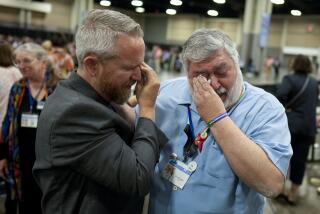Catholic Bishops Suggest New Rules on Cremation
- Share via
No one is saying that the ashes of deceased family members should be scattered into the ocean. And Catholics should still forget about keeping the remains in a jar on a fireplace mantle.
But a committee of bishops says families should no longer have to leave the cremated remains of a loved one outside in the hearse during a funeral Mass.
In an action that addresses one of the most profound mysteries of the Christian faith--how human beings receive eternal life after death--the Committee on the Liturgy is urging the church to appeal to the Vatican to lift the ban on bringing the ashes of the deceased into church.
This is a faith that distinguished itself from pagan Roman culture in its earliest days by its practice of burying rather than cremating the dead. Now, because of changes in American culture, the church is being asked to reconsider its insistence that the body be preserved for funeral Masses.
The discussion reflects an evolving attitude among many people in the pews, who no longer assume an intact body is the best preparation for resurrection.
“If the Lord can resurrect a body, he can certainly get all the parts back together again,” says Monsignor Alan Detscher, director of the Secretariat for the Liturgy.
The committee’s proposal will be presented to the National Conference of Catholic Bishops at its spring meeting next week in Portland, Ore.
Cremation was forbidden in the Catholic Church until 1963, when allowances were made for the practice in cases of necessity and only as long as cremation was not chosen as a sign denying belief in the resurrection of the dead.
Two generations ago, Bishop Emil Wcela said, “the idea was somehow the physical body you have now was going to be reconstituted in a new way.”
As cremation has become more accepted, the thinking has shifted to focus more on the notion that resurrection involves, in some mysterious way, the identity--not just the physical matter--of the person.
Today, however, cremation has become common for economic, rather than theological, reasons. It is cheaper to cremate a body than pay for a casket and burial services. In 1990, 17% of Catholic funerals involved cremation, and the percentage is expected to rise to more than 20% by 2000.
The Rev. William Rusch, director of the Faith and Order Commission of the National Council of Churches, said most mainline Protestant churches do not make an issue of permitting the ashes inside at a funeral service.
And the Catholic Church in Canada and three dioceses in the United States have already received permission from the Vatican to allow the practice.
Now, mindful that the ban has become a source of conflict in many local parishes, the bishops’ committee is recommending the change for the entire church in the United States.
Detscher said it is painful for families to leave the remains of their loved one out in the car while the funeral liturgy is celebrated inside.
But there is still a clear preference for burying the body in a grave as Jesus was, or at the least, delaying cremation until after the funeral Mass, the bishops said.
“Christians are unequivocally confronted by this mystery of life and death when faced with the presence of the body of one who has died. That body forcefully brings to mind our belief that our human bodies are temples of the Holy Spirit and destined for future glory at the resurrection of the dead,” the bishops said.
If cremation is chosen, the bishops said, the remains should be treated with respect and entombed in a mausoleum or columbarium, not scattered in the air or stored casually in the home.
“So much is unknown about this life after death,” the bishops said. “There is much that the Christian must await in hope.”
In the long term, it does not matter whether a body is cremated or decomposes naturally. “Either way,” Bishop Wcela said, “the body is reduced to ash.”
More to Read
Sign up for Essential California
The most important California stories and recommendations in your inbox every morning.
You may occasionally receive promotional content from the Los Angeles Times.












